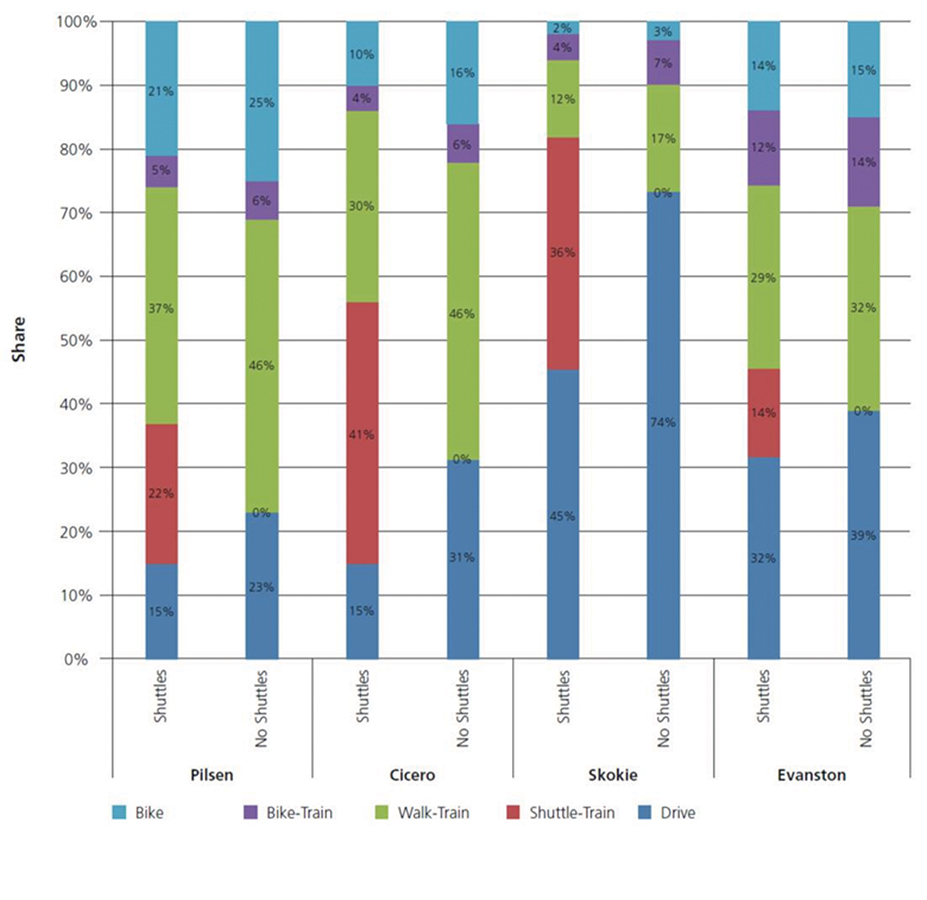U.S. Department of Transportation
Federal Highway Administration
1200 New Jersey Avenue, SE
Washington, DC 20590
202-366-4000
Federal Highway Administration Research and Technology
Coordinating, Developing, and Delivering Highway Transportation Innovations
| SUMMARY REPORT |
| This summary report is an archived publication and may contain dated technical, contact, and link information |
| Publication Number: FHWA-HRT-15-015 Date: June 2015 |
Publication Number: FHWA-HRT-15-015 Date: June 2015 |
Results from the integrated model showed that the presence of the community transit and urban-design improvements had a marked effect on the sample population. Modeling with and without community transit and a set of urban amenities resulted in noticeable reductions in driving, as shown in figure 5. The decrease in the percentage of travelers who drove cars on their commuting trips varied between 7 percent and 29 percent, with the largest percentage-point reductions seen in the more auto-oriented areas of Cicero (16 percent) and Skokie (29 percent). Auto-use reductions were also significantly lower in areas with greater transit use to begin with; specifically Pilsen (8 percent) and Evanston (7 percent). The increase in the percentage of travelers who used the train varied between 9 percent and 28 percent, with more auto-oriented Skokie (28 percent) and Cicero (23 percent) exceeding the denser Pilsen (12 percent) and Evanston (9 percent). CTA mode shares among the modeled population increased from 24 percent to 52 percent in Skokie, 46 percent to 55 percent in Evanston, 52 percent to 75 percent in Cicero, and 52 percent to 64 percent in Pilsen. Across all neighborhoods, the results indicated that community transit might possibly decrease car use for these trips from the current 36 percent to 22 percent and increase CTA share from its current 50 percent to 67 percent. Community transit was shown to produce the greatest change in the lower density areas of Skokie and Cicero.
Differences by Land-Use Density
One of the most robust findings in the project was that the community shuttle produced greater change in the lower density areas of Skokie and Cicero. These less dense neighborhoods were more sensitive to higher parking costs, streetscape improvements, and the shuttle service than were the denser and more pedestrian-oriented neighborhoods (Pilsen and Evanston). Results from the stated-preference survey questions suggest that the shift from car to transit would be even greater if supported by policy changes that affect the cost of driving.
In contrast, where environments are more urban in character with walkable neighborhoods, more accessible transit, and higher parking costs, fewer gains may be realized with a community shuttle. For example, Evanston was the least responsive to the shuttle service—bus service to its CTA and Metra stations is already quite good. The higher density in central Evanston would also explain why the community shuttle service and street improvements seem to serve different populations: Shuttles would likely target residents living further away but close to shuttle routes, whereas streetscape improvements target commuters who have to spend more time walking across the neighborhood. As a result, the effects of applying each policy independently add up in the combination scenario.

© University of Michigan
Figure 5. Combined model results using the neighborhood best fit coefficients comparing and testing the effect of community transit.
The first level of improvements represented in the survey was the community shuttle with a bicycle lane; the shifts in respondents’ mode choices occurred at this level. The second level of improvements, urban design improvements with the shuttle and bicycle facilities, showed minimal further shifts. Extensive urban design improvements beyond the bike lane were tested, and none of them had a measurable impact on mode choice in the study. As a result, although there is support in the mode-choice literature for the potential of urban design improvements to reduce driving, this research did not generate additional empirical evidence for that hypothesis. Streetscape improvements tended to support transit use for residences closer to train stations. Results from the activity-based model suggest that of the design variables, the frequency of the shuttle service had the greatest influence on its use.
The researchers also asked whether the presence of pedestrians, cyclists, and other transit users in greater numbers would affect traveler’s perceptions and shift mode choices to transit. Three levels of use were represented in the survey images for the transportation and urban design improvements. This hypothesis was tested in agent-based and activity-based modeling, and neither found an effect.
Running the model with and without community transit for each neighborhood shows that adding shuttles can lead to noticeable reductions in driving.